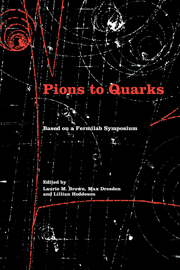Book contents
- Frontmatter
- Contents
- List of contributors
- Foreword by Leon M. Lederman
- Editors' acknowledgments
- Photographs of the symposium
- List of abbreviations
- List of notation
- I Introduction
- II Particle discoveries in cosmic rays
- III High-energy nuclear physics
- IV The new laboratory
- V The strange particles
- VI Weak interactions
- 24 Detection of the neutrino
- 25 Recollections on the establishment of the weak-interaction notion
- 26 Symmetry and conservation laws in particle physics in the fifties
- 27 A connection between the strong and weak interactions
- 28 The weak interactions from 1950 to 1960: a quantitative bibliometric study of the formation of a field
- VII Weak interactions and parity nonconservation
- VIII The particle physics community
- IX Theories of hadrons
- X Personal overviews
- Name index
- Subject index
24 - Detection of the neutrino
Published online by Cambridge University Press: 07 May 2010
- Frontmatter
- Contents
- List of contributors
- Foreword by Leon M. Lederman
- Editors' acknowledgments
- Photographs of the symposium
- List of abbreviations
- List of notation
- I Introduction
- II Particle discoveries in cosmic rays
- III High-energy nuclear physics
- IV The new laboratory
- V The strange particles
- VI Weak interactions
- 24 Detection of the neutrino
- 25 Recollections on the establishment of the weak-interaction notion
- 26 Symmetry and conservation laws in particle physics in the fifties
- 27 A connection between the strong and weak interactions
- 28 The weak interactions from 1950 to 1960: a quantitative bibliometric study of the formation of a field
- VII Weak interactions and parity nonconservation
- VIII The particle physics community
- IX Theories of hadrons
- X Personal overviews
- Name index
- Subject index
Summary
The efforts that came to fruition with the detection of the free neutrino started at Los Alamos in 1950–1, when several of us who were engaged in the testing of nuclear bombs wondered if that man-made star could be used to advance our knowledge of physics. For one thing, the unusual object featured lots of fissions, followed by β decays; so why not use it as a source of neutrinos? After all, it is an extraordinarily intense pulse, and signals produced by such a source might be sufficiently copious and distinguishable from background. Some hand-waving and rough estimates led me to conclude that the bomb was, in fact, the best source. All that was required was a massive detector, measuring a cubic meter or so.
As it happened, Enrico Fermi was at Los Alamos during the summer of 1951, and I took the opportunity to talk with him about these matters. The conversation went something as follows: “I would like to talk with you a few minutes about the possibility of neutrino detection.” He was very pleasant, and said, “Well, tell me what is on your mind.” “First off as to the source,” I said, “I think that the bomb is best.” After a few moments thought he replied, “Yes, the bomb is the best source.” So far so good. And then I said, “But one needs a detector which is so big and I don't know how to make such a detector.” He thought about it further and said he didn't know either.
- Type
- Chapter
- Information
- Pions to QuarksParticle Physics in the 1950s, pp. 359 - 366Publisher: Cambridge University PressPrint publication year: 1989



